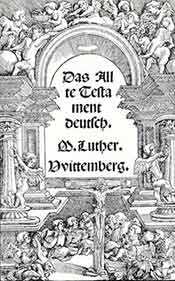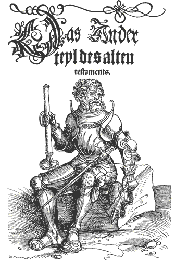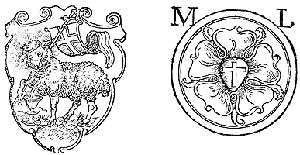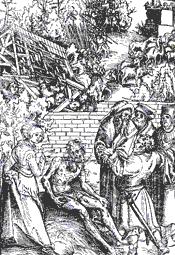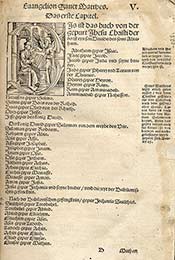The Gruber Rare Books Collection and Other Rare Books
Luther's Bible Translations: 1523-33
Luther's Translation of the Pentateuch 1523
Gruber 30 Das Allte Testament deutsch M. Luther. Wittemberg, n.d., but 1523. This book contained Luther's translation of the Pentateuch. There are eleven woodcuts, and six of these are pictures of the exterior or interior of the tabernacle. The other five: the high priest in vestments; the flood; the sacrifice of Isaac; Jacob's dream; and Joseph interpreting Pharaoh's dream. These woodcuts are colored in the Gruber copy.
Luther used a Hebrew Bible that had been published in Brescia in 1494. Luther used the commentaries of Nicolas of Lyra and the grammar and lexicon of Reuchlin. Luther immersed himself deeply in passages, listening to them from within, and then asked whether what he thought he was hearing agreed with the letter of the text and was grammatically acceptable. Luther struggled with Leviticus, which he regarded as tiresome and having little spiritual perspective.
Luther: "I have made a great effort to make Moses so German that no one would guess that he was a Jew."
In the Preface Luther wrote: "It is the principal teaching of the Old Testament to proclaim the law, to reveal sin, and to further the good....For Moses can do no more by the law than tell what man ought to do and ought not to do. But he cannot give the power, the strength, and the ability to fulfill it." Large portions of this Preface are contained in
Willem Jan Kooiman, Luther and the Bible, 135-144.
Luther's Translation of the Second Part of the Old Testament: Joshua-Esther 1524
Gruber 39 Das Ander teyl des alten testaments. Wittenberg. Date 1524 penciled in on title. Joshua-Esther
The armed soldier on the title page points to the warlike events in these books. There are 23 illustrations, of which five picture the temple.
This lamb, with the banner of victory, and Luther's seal appear on the final page. Luther wrote: "These symbols are evidence that this book is authorized by me, for there is no end to the reprinting and adulterating of books."
Luther's Translation of the Third Part of the Old Testament: Job-Song of Solomon 1524
Gruber 40 Das Dritte teyl des allten Testaments.
Wittemberg MDXXIIII (1524).
Job, Psalms, Solomon
(=Proverbs, Ecclesiastes, Song of Solomon)
Note that David, the Prophets, and Moses,
at the top of the picture, point to Christ.
Pictured are Job and his wife. Job sits on an ash heap, with friends surrounding him. A servant announces the many catastrophes that are portrayed in the background of the picture. The picture demonstrates that good works cannot attain salvation, the foolishness of cleverness in this world, and the lack of freedom of the will.
Luther's Translation of the New Testament, 1524 and 1530 Editions
Gruber 58 Luther's New Testament. Wittenberg: Melchior und Michel Lotther, MDXXIIII (1524). Lacks title page.
Gruber 59. Das Newe Testament Mar. Luthers.
Wittemberg: Hans Lufft, MDXXX (1530)
Luther's Translation of the Prophets 1532
Gruber 34 Die Propheten alle Deudsch D. Mart. Luth. Wittemberg MDXXXII (1532). Prophets. In a letter to Wenzeslaus Link, Luther wrote: "We are now sweating over a German translation of the Prophets. O God, what a hard and difficult task it is to force these writers, quite against their wills, to speak German!"
A few illustrations that had been used in his translations of Isaiah and Daniel appeared again in this volume. Luther provided an introduction to each prophet and to the prophets as a whole.
The Gruber Collection was assembled by L. Franklin Gruber, President of Chicago Lutheran Theological Seminary, Maywood, Illinois.
Annotation prepared by Ralph W Klein
